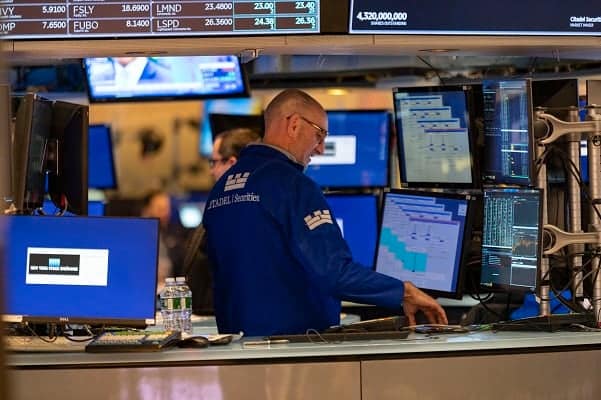The upward momentum of the Dow Jones (US30) is showing clear signs of slowing as the index faces pressure from multiple fronts — including escalating tariff risks, mounting U.S. public debt, and an increasingly conflicted monetary–fiscal policy environment.
Although the Federal Reserve has begun easing financial conditions through rate cuts, Wall Street investors remain hesitant to return to sustained equity buying, particularly in the industrial and financial sectors that make up a large share of the index.
The most significant factor weighing on the Dow Jones is the new tariff announcements from the administration of President Donald Trump. The U.S. government’s plan to impose 100% tariffs on imports from China starting November 1, 2025, coupled with fears of Chinese retaliation, triggered a sharp market correction late last week.
Leading industrial giants within the Dow — including Caterpillar, 3M, Honeywell, Boeing, and United Technologies — all suffered notable declines last week as investors grew concerned about potential margin compression. These firms have deep supply-chain exposure to China, spanning components, electronics, and raw materials. According to Bloomberg Economics, if the 100% tariff is fully implemented, input costs for U.S. industrial companies could rise by 5–7%, while net profit margins could narrow by 0.4–0.6 percentage points.
Beyond the industrial sector, financial and retail stocks have also come under pressure as fourth-quarter earnings growth expectations are revised downward. Goldman Sachs, JPMorgan, and American Express — three heavyweight components of the Dow Jones — all recorded moderate selling pressure in recent sessions amid concerns over rising public debt and volatile interest rates.
From a macroeconomic perspective, the Fed has officially begun its first rate-cutting cycle after more than two years of tightening, and markets are pricing in another 25-basis-point cut in November. However, the 10-year real yield (TIPS) remains elevated around 1.75%, reflecting that inflation expectations have not fallen substantially and demand for long-term Treasuries remains weak.
The main reason lies in the ballooning U.S. public debt, now exceeding $37 trillion, alongside massive Treasury issuance to finance the fiscal deficit. As a result, corporate borrowing costs have not eased meaningfully, limiting expectations for a robust earnings rebound. Capital-intensive sectors — including industrials, construction, energy, and financials, which form the core of the Dow Jones — are therefore facing direct headwinds.
Meanwhile, the ongoing U.S. government shutdown is further complicating the macro picture, with key data releases such as CPI, PPI, and Retail Sales at risk of being delayed. This has plunged markets into a “data fog,” leaving investors without the information needed to gauge monetary policy direction. In such an environment, institutional funds are tending to raise cash positions, cut equity exposure, and shift toward safer assets like gold and short-term bonds, leading to a visible weakening in equity inflows.
On the geopolitical front, uncertainty remains high. In the Middle East, the Phase 1 ceasefire agreement between Israel and Hamas has temporarily eased tensions, but focus has shifted to Eastern Europe, where the U.S. is considering supplying Tomahawk cruise missiles to Ukraine — a move that Moscow has labelled a “serious escalation.” Such developments have increased geopolitical risk premiums in asset pricing and boosted safe-haven demand, weighing on U.S. equities in the short term.
In the near term, the Dow Jones is likely to continue trading within a narrow range, as the opposing forces of Fed easing expectations and tariff concerns cancel each other out. Should the White House adopt a softer tone on trade or the Fed signal a faster pace of rate cuts, the index could regain upward momentum. Conversely, if tariff risks expand into shipping and logistics, particularly as reciprocal U.S.–China port fees come into effect, rising supply-chain costs could push the Dow further downward toward lower support levels.

